Welcome to our in-depth exploration of the captivating aquatic plant, Pogostemon Stellatus ‘Octopus.’ For aquarium enthusiasts and aquatic gardeners, this rare plant holds great appeal.
With its unique visual characteristics and ability to thrive in freshwater tanks, ‘Octopus’ is a delightful addition to any planted aquarium.
In this article, we will delve into the origins and natural habitat of Pogostemon Stellatus ‘Octopus.’
We will also discuss its significance within the aquatic plant community, offering insights into its care requirements and how it can be incorporated into stunning aquascapes.
Whether you’re a seasoned aquarist or just starting your aquatic gardening journey, join us as we uncover the wonders of this exceptional plant.
Key Takeaway
- Pogostemon Stellatus ‘Octopus’ is a unique and rare aquatic plant that adds beauty and interest to freshwater aquariums.
- Understanding the origin and natural habitat of ‘Octopus’ plants provides valuable insights into their care requirements.
- The significance of Pogostemon Stellatus ‘Octopus’ in the aquatic plant community highlights its desirability among aquarium enthusiasts.
- Proper care and maintenance, including lighting, water chemistry, and nutrient availability, are crucial for the successful cultivation of ‘Octopus’ plants.
- By incorporating ‘Octopus’ plants into aquascapes, you can create visually striking underwater landscapes that showcase the unique characteristics of this plant.
Quick Stats
| Attribute | Details |
| Family Name | Lamiaceae |
| Origin | Cultivar derived from Southeast Asia |
| Height | 15-30 cm (6-12 inches) |
| pH Range | 6.0 – 7.5 |
| CO2 Requirement | Moderate to High |
| Growth Rate | Moderate to Fast |
| Care Level | Moderate |
| Color Form | Green |
| Water Conditions | 22-28°C (72-82°F), soft to moderately hard water |
| Max Size | 15-30 cm (6-12 inches) in diameter depending on conditions |
| Lighting | Moderate to High |
| Supplements | Requires nutrient-rich substrate and regular liquid fertilization |
| Placement | Background |
| Propagation | Stem cuttings and lateral shoots |
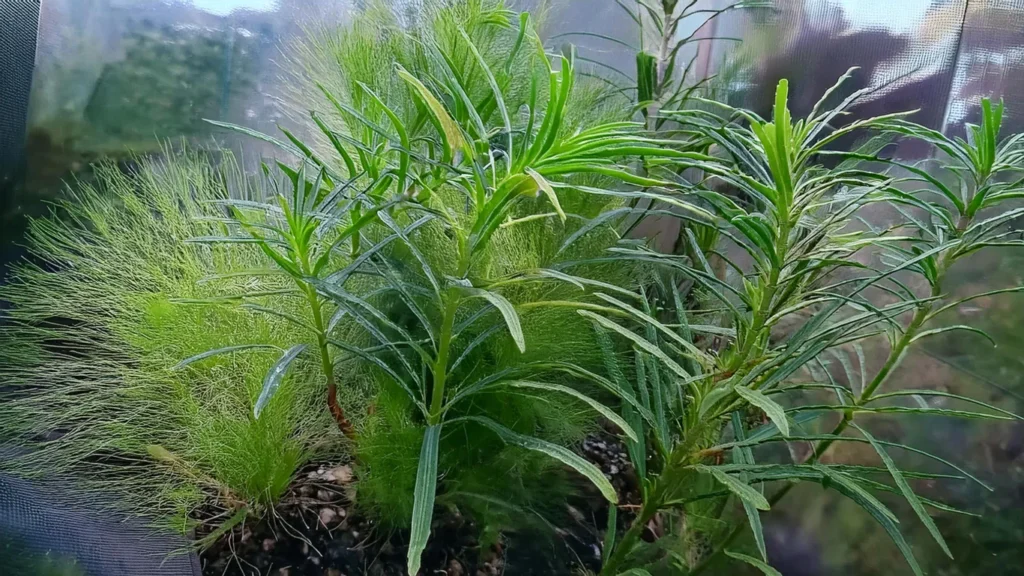
What Is Pogostemon Stellatus ‘Octopus’?
In this section, we will provide an overview of Pogostemon Stellatus ‘Octopus,’ a captivating aquatic plant that has gained popularity in the aquarium hobby.
Its unique visual appeal and adaptability make it a favorite among aquarists. Let’s dive deeper into this fascinating aquatic plant’s origin, natural habitat, distribution, and significance.
Origin And History
- Pogostemon Stellatus ‘Octopus’ belongs to the family Lamiaceae and is native to Southeast Asia, specifically India, where it was first discovered. Over the years, it has gained recognition for its striking appearance, resembling the tentacles of an octopus, hence its name.
- This plant has become increasingly sought after by aquarists worldwide due to its beautiful and delicate foliage.
RELATED: Exploring The Beauty Of Lysimachia Nummularia Green
Natural Habitat And Distribution
- Within its natural habitat, Pogostemon Stellatus ‘Octopus’ can be found growing along the banks of slow-moving or stagnant water bodies, such as ponds, lakes, and marshes. It thrives in areas with moderate light levels and warm temperatures.
- This aquatic plant is mainly distributed in Asia’s tropical and subtropical regions, including India, Malaysia, and Thailand, making it a valuable addition to any aquascape inspired by these regions.
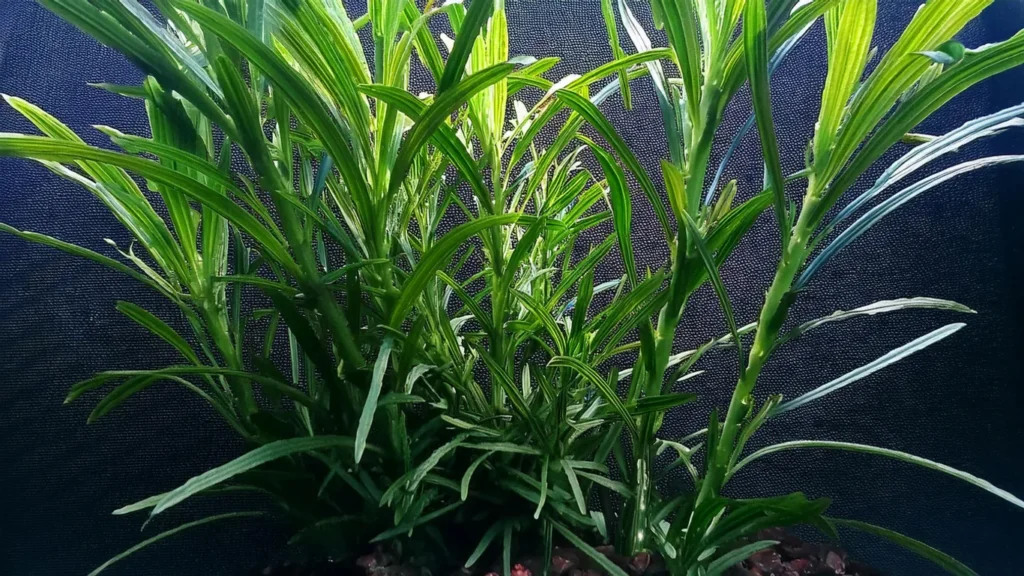
Visual Characteristics Of Octopus Plants
- The Pogostemon Stellatus ‘Octopus’ features long, branching leaves that resemble the tentacles of an octopus, hence its name. These graceful and delicate leaves sway gently in the water, adding movement and elegance to your aquascape.
- The vibrant green color of the foliage brings a refreshing and natural touch to the aquarium, creating a soothing and serene ambiance. The vibrant hue of the leaves contrasts beautifully against the backdrop of other plants and decorations, making it a focal point in the tank.
- Due to its slender and elongated growth pattern, the ‘Octopus’ plant can add height and vertical interest to the aquascape, creating a visually striking composition. Its unique appearance makes it ideal for creating depth and dimension in the underwater landscape.
Lighting Requirements For Your Pogostemon Stellatus ‘Octopus’
- Proper lighting is crucial for the growth of Pogostemon Stellatus ‘Octopus’. This plant requires moderate to high light intensity to thrive.
- Provide it with at least 6 to 8 hours of light per day. Consider using full-spectrum LED or fluorescent lights to meet its lighting needs.
Temperature Parameters
- Pogostemon stellatus ‘Octopus’ thrives best in aquariums with temperatures ranging from 72°F to 82°F (22°C to 28°C), mirroring its natural habitat conditions.
- Consistency in maintaining water temperatures within this range is crucial for promoting robust growth and overall health of the plant.
- Fluctuations or extremes in temperature can stress the plant, leading to stunted growth, wilting, or even plant death.
- Use of aquarium heaters and regular monitoring of water temperature help ensure the stability of the aquatic environment, providing an optimal setting for Pogostemon stellatus ‘Octopus’ to flourish.
- Adjusting the temperature to the recommended range supports the plant’s physiological processes, including photosynthesis and nutrient uptake, contributing to its vibrant appearance and vitality.

Water Chemistry
- Ensure the water chemistry is suitable for Pogostemon Stellatus ‘Octopus’ to flourish. Keep the pH level between 6.5 and 7.5, while the water hardness should be in the range of 3 to 8 dKH (carbonate hardness).
- Maintaining optimal water conditions creates a favorable environment for growth.
Substrate Requirement
- Nutrient-Rich Substrate: Use a nutrient-rich substrate to provide essential nutrients for the plant’s growth. Quality substrates specifically formulated for aquatic plants are recommended.
- Fine-grained Substrate: Pogostemon Stellatus ‘Octopus’ prefers a fine-grained substrate such as aquarium soil or fine gravel. This substrate type allows for proper root anchoring and nutrient uptake.
- Depth: Provide a substrate layer of at least 2-3 inches (5-8 cm) to allow the plant’s roots to spread and anchor securely.
- Substrate Additives: Consider adding substrate additives like root tabs or fertilizer pellets to enrich the substrate with essential nutrients, especially if using inert substrates like sand or gravel.
- Aquarium Compatibility: Ensure that the substrate chosen is compatible with the overall setup of your aquarium and the needs of other aquatic species present. Avoid substrates that may alter water chemistry or cause adverse effects on water parameters.
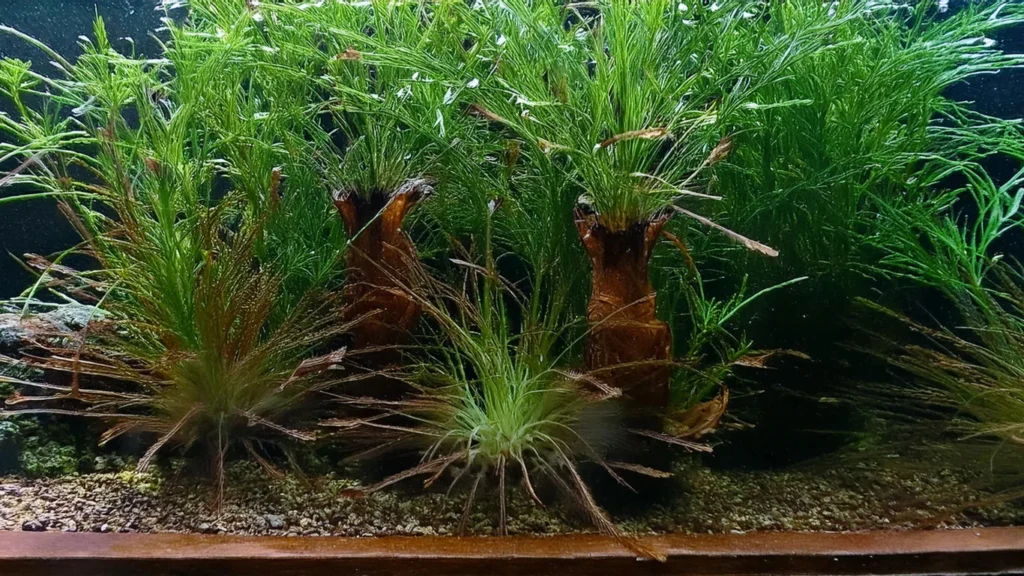
Placement Option
- Background or Midground: Pogostemon Stellatus ‘Octopus’ can be placed as a background or midground plant in the aquarium. Its tall and slender stems make it suitable for placement towards the back or sides of the tank.
- Cluster Planting: Planting several stems of Pogostemon Stellatus ‘Octopus’ together in clusters can create a visually appealing effect. Arrange the clusters towards the back or sides of the tank to provide a lush green backdrop.
- Foreground Accent: While primarily a background plant, shorter stems of Pogostemon Stellatus ‘Octopus’ can also be used as a foreground accent. Plant them strategically in the foreground to add depth and dimension to the aquascape.
Recommended Tank Size
- Pogostemon Stellatus ‘Octopus’ thrives best in larger aquariums, primarily due to its tall and slender growth habit, which requires ample space to spread out and reach its full potential.
- Providing a tank size of at least 20 gallons (75 liters) or more is recommended to accommodate the plant’s growth without crowding other aquatic flora. This larger tank capacity not only offers more room for the plant to develop but also enhances water stability by diluting any fluctuations in water parameters.
- The spacious environment of larger tanks allows for better water circulation and nutrient distribution, which are crucial for promoting the robust growth of Pogostemon Stellatus ‘Octopus’. This ensures that the plant receives an adequate supply of essential nutrients to support its development.
- Additionally, larger tanks provide a more stable environment, making it easier to maintain optimal water conditions for the plant’s health and vitality. With sufficient space, aquarists can implement effective maintenance routines, such as water changes and pruning, to keep the tank clean and conducive to plant growth.
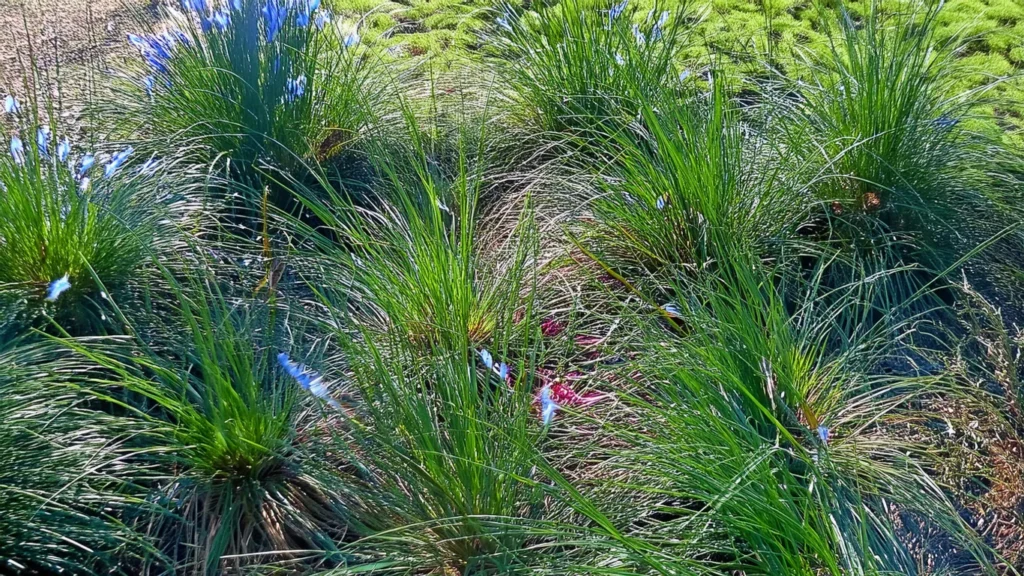
Compatibility With Fish And Invertebrates
- Pogostemon Stellatus ‘Octopus’ is generally compatible with many fish species. Its dense growth and branching leaves provide ample hiding places and cover for small fish, making it an excellent addition to community tanks. However, it is important to consider the specific needs and behaviors of individual fish species to ensure compatibility.
- When choosing tankmates for Pogostemon Stellatus ‘Octopus,’ it is advisable to select peaceful species that won’t disturb the delicate foliage or uproot the plant. Avoid aggressive fish that may nip at the leaves or disrupt the plant’s growth. Additionally, keep in mind the preferred water parameters and temperature requirements of both the plant and the fish to ensure a suitable environment for all inhabitants.
Nutrient Requirements
- Pogostemon Stellatus ‘Octopus’ benefits from a nutrient-rich substrate and regular fertilization. Add a nutrient substrate or root tabs to provide the plant with essential nutrients.
- Supplement with liquid fertilizers that contain macronutrients, such as nitrogen, phosphorus, and potassium, to support healthy growth.

Pogostemon Stellatus Cultivation Tips
- Lighting: Provide moderate to high lighting conditions, preferably around 2-3 watts per gallon of full spectrum lighting. This will encourage healthy growth and prevent the plant from becoming leggy.
- Water Parameters: Maintain stable water parameters with a pH range of 6.5-7.5 and a water hardness of 3-8 dKH. CO2 supplementation is beneficial for promoting lush growth, but Pogostemon Stellatus can adapt to a wide range of conditions.
- Nutrient Requirements: Ensure a well-balanced nutrient regime with regular dosing of macro and micronutrients. Iron supplementation can help prevent leaf yellowing and promote vibrant green coloration.
- Substrate: Plant Pogostemon Stellatus in a nutrient-rich substrate to provide essential nutrients for root development. Adding a layer of nutrient-rich substrate such as aqua soil or a nutrient-rich substrate fertilizer can enhance growth.
- Pruning: Regular pruning is essential to maintain the plant’s shape and prevent overcrowding. Trim any excess growth and remove any dead or decaying leaves to promote healthy growth and prevent nutrient depletion.
Plant Propagation Tips
- Stem Cuttings: Pogostemon Stellatus propagates readily from stem cuttings. Simply cut a healthy stem from the mother plant using sharp, sterile scissors. Ensure the cutting is at least a few inches long and has several nodes. Remove any leaves from the bottom portion of the cutting to expose the nodes. Plant the cutting in the substrate, burying at least one or two nodes to encourage root growth. Maintain high humidity and provide adequate lighting and nutrients to promote successful rooting.
- Root Division: If the Pogostemon Stellatus has developed a dense root system, you can divide the plant by carefully separating the root mass into smaller sections. Use sharp, sterile scissors or a knife to divide the roots, ensuring that each division has several stems and a healthy root system. Plant each division in the substrate, ensuring that the roots are buried and the stems are above the substrate. Provide appropriate care to encourage new growth from each division.
- Adventitious Plantlets: Pogostemon Stellatus may produce adventitious plantlets along its stems, especially under optimal growing conditions. These plantlets can be gently detached from the mother plant once they have developed their own root system. Plant the plantlets in the substrate, ensuring that the roots are buried and the stems are above the substrate. Provide appropriate care to support the growth of the new plants.
- Floating Stem Cuttings: Another method of propagation involves allowing stem cuttings to float on the water’s surface. Simply cut a healthy stem from the mother plant and place it gently on the water’s surface. Over time, the cutting will develop roots, and new shoots will emerge from the submerged nodes. Once roots have formed, the cutting can be planted in the substrate or left to float as a floating plant.
Benefits Of Planting Pogostemon Stellatus
- Aesthetic Enhancement: Pogostemon Stellatus, with its vibrant green coloration and distinctive leaf shape, adds visual interest and enhances the overall aesthetic appeal of your aquarium. Its bushy growth habit and attractive foliage create a lush and natural-looking underwater landscape.
- Oxygenation: Like other aquatic plants, Pogostemon Stellatus contributes to oxygenation of the water through photosynthesis. This helps maintain optimal oxygen levels for fish and other aquatic inhabitants, promoting their health and well-being.
- Water Filtration: The dense growth of Pogostemon Stellatus can help improve water quality by absorbing excess nutrients such as nitrates and phosphates from the water column. This natural filtration process helps reduce algae growth and maintain a balanced aquatic ecosystem.
- Habitat Enhancement: Pogostemon Stellatus provides shelter and hiding places for small fish, shrimp, and other aquatic creatures. The dense foliage offers refuge for shy or vulnerable species, reducing stress and promoting natural behavior.
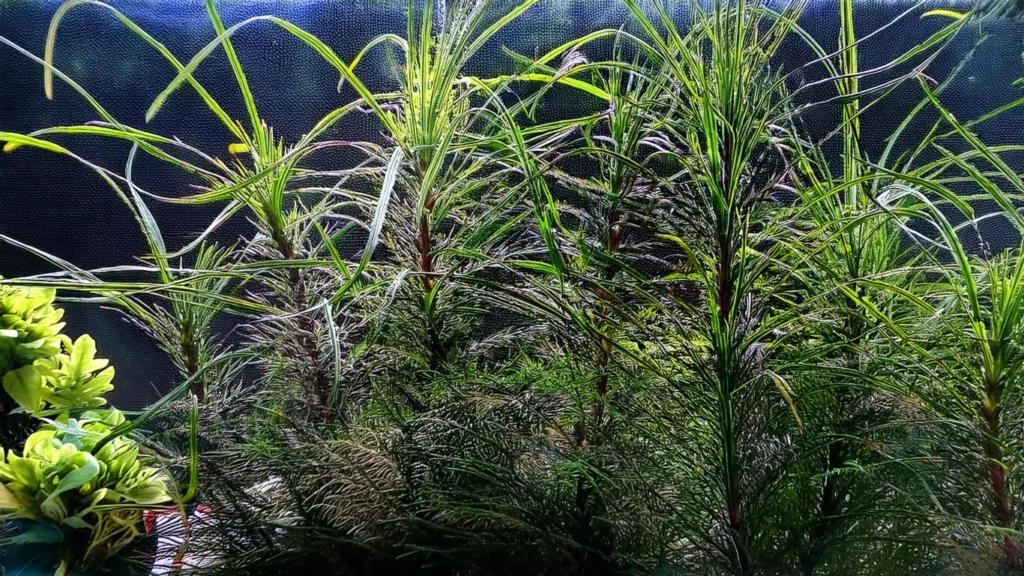
Conclusion
Pogostemon Stellatus ‘Octopus’ is a remarkable aquatic plant that offers a unique and captivating addition to any aquarium.
With its beautiful branching leaves and striking appearance, it can enhance the visual appeal of your aquascape.
When it comes to care, ‘Octopus’ plants require specific attention to lighting, water chemistry, and nutrient availability.
By providing the right conditions, you can ensure the health and vitality of your plants, promoting their growth and longevity.
Furthermore, Pogostemon Stellatus ‘Octopus’ not only brings aesthetic beauty to your aquarium but also plays an important role in the ecosystem.
It provides shelter and refuge for small fish and invertebrates, contributing to a balanced aquatic environment.
Frequently Asked Questions
How Important Is Lighting For The Cultivation Of Pogostemon Stellatus ‘octopus’?
Adequate lighting is crucial for the healthy growth of Pogostemon Stellatus ‘Octopus.’
It requires moderate to high lighting levels, around 3 to 4 watts per gallon, to thrive and showcase its vibrant green color.
How Can I Propagate Pogostemon Stellatus ‘octopus’?
Pogostemon Stellatus ‘Octopus’ can be propagated through stem cuttings.
Simply snip a healthy stem and plant it in the substrate, ensuring it has access to sufficient light and nutrients for successful propagation.
What Are Common Issues Faced In Growing Pogostemon Stellatus ‘octopus’?
Common issues in growing Pogostemon Stellatus ‘Octopus’ include inadequate lighting, nutrient deficiencies, and algae overgrowth.
Regular trimming and maintenance can help address these issues and promote healthy growth.
Is Pogostemon Stellatus ‘octopus’ Suitable For Community Tanks?
Pogostemon Stellatus ‘Octopus’ can be compatible with many fish and invertebrates.
However, it is important to consider the specific needs and behaviors of the other tank inhabitants to ensure a harmonious and balanced ecosystem.
What Are Some Design Ideas For Incorporating Pogostemon Stellatus ‘octopus’ Into Aquascapes?
Pogostemon Stellatus ‘Octopus’ can be used as a focal point in a natural-inspired aquascape or as part of a more artistic and intricate design.
Its long and branching leaves can be arranged to create visually appealing underwater landscapes.
- Unveiling The Wonders Of Riccia Fluitans In Aquascapes - August 7, 2024
- Vallisneria Gigantea Var. Guide To Care And Cultivation At Home - July 31, 2024
- Vesicularia Dubyana Care & Growth Guide Tips For Beginner Gardeners - July 30, 2024
